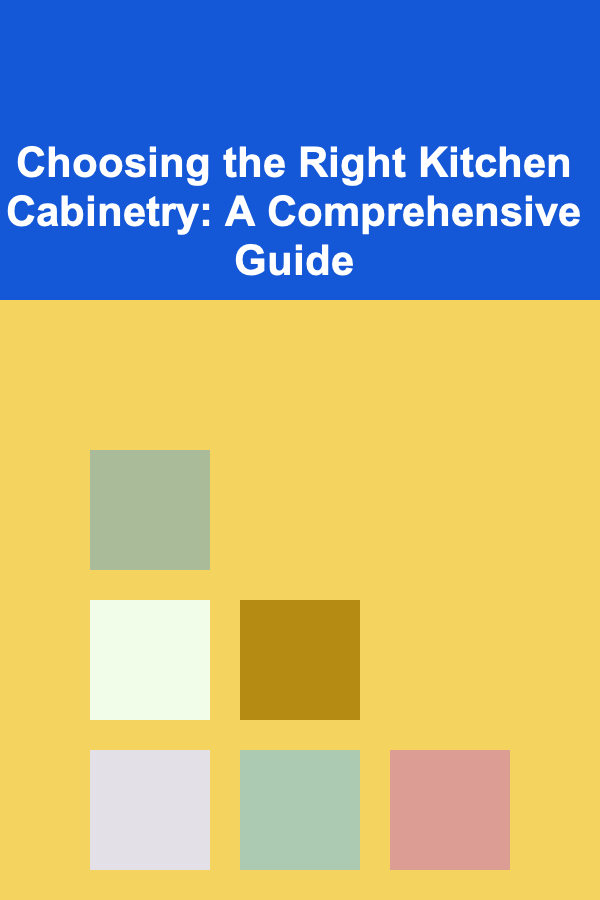
Choosing the Right Kitchen Cabinetry: A Comprehensive Guide
ebook include PDF & Audio bundle (Micro Guide)
$12.99$11.99
Limited Time Offer! Order within the next:

The kitchen, often hailed as the heart of the home, is a space where culinary creations come to life, families gather, and memories are made. At the core of every functional and aesthetically pleasing kitchen lies its cabinetry. Choosing the right kitchen cabinetry is a significant investment that impacts not only the visual appeal of your space but also its practicality and long-term value. This comprehensive guide delves into the intricacies of selecting the perfect cabinetry, covering everything from understanding your needs and style preferences to exploring different materials, construction methods, and finishing options. By carefully considering these factors, you can create a kitchen that is both beautiful and perfectly suited to your lifestyle.
Defining Your Needs and Style
Before diving into the vast world of cabinet options, it's crucial to take a step back and analyze your specific needs and desired aesthetic. This initial planning stage will serve as a roadmap, guiding you through the decision-making process and ensuring you choose cabinetry that truly complements your lifestyle.
a. Assessing Your Storage Requirements
Begin by evaluating your current kitchen storage situation. Are you constantly struggling with overflowing cabinets? Do you find it difficult to locate specific items? Identifying your storage pain points is the first step towards creating a more organized and efficient kitchen.
- Inventory Your Belongings: Take stock of all the items you need to store in your kitchen, including cookware, dishes, pantry items, small appliances, and utensils. Consider the size and shape of these items.
- Identify Storage Zones: Think about how you use your kitchen and group items based on their function. For example, create a zone for baking supplies, a zone for cooking utensils, and a zone for dishware.
- Consider Vertical Space: Maximize vertical space by utilizing tall cabinets, pull-out shelves, and adjustable shelving. These features can significantly increase storage capacity without expanding the footprint of your kitchen.
- Think About Special Storage Solutions: Explore specialized storage solutions such as pull-out pantries, spice racks, pot and pan organizers, and drawer dividers. These features can help you keep your kitchen clutter-free and easily accessible.
b. Determining Your Kitchen Layout and Space Constraints
The existing layout of your kitchen will significantly influence your cabinet choices. Consider the available space, the placement of appliances, and the overall flow of the room.
- Measure Your Kitchen: Accurately measure the dimensions of your kitchen, including wall lengths, ceiling height, and the location of windows and doors. Create a detailed floor plan to visualize the space.
- Consider the Work Triangle: The work triangle, which connects the sink, refrigerator, and cooktop, is a fundamental concept in kitchen design. Ensure that your cabinet layout supports an efficient and ergonomic work triangle.
- Account for Appliance Placement: Plan the placement of your appliances carefully, taking into account the necessary clearances and ventilation requirements. This will affect the size and configuration of your adjacent cabinets.
- Think About Traffic Flow: Ensure that your cabinet layout allows for comfortable movement throughout the kitchen. Avoid creating bottlenecks or obstructing walkways.
c. Defining Your Style Preferences
Your personal style should be reflected in every aspect of your kitchen, including the cabinetry. Consider the overall aesthetic you want to achieve, whether it's traditional, modern, farmhouse, or something else entirely.
- Gather Inspiration: Browse magazines, websites, and social media platforms to gather inspiration for your kitchen design. Create a mood board to visualize your desired aesthetic.
- Identify Key Style Elements: Pay attention to the details that define different design styles, such as cabinet door styles, hardware finishes, and color palettes.
- Consider the Existing Architecture: Your kitchen cabinetry should complement the existing architecture of your home. For example, a traditional home might benefit from more ornate cabinetry, while a modern home might call for sleek and minimalist designs.
- Choose a Color Palette: Select a color palette that reflects your personal style and complements the other elements of your kitchen. Consider using a combination of neutral and accent colors to create visual interest.
Exploring Cabinet Construction and Materials
The construction and materials used in kitchen cabinetry directly impact its durability, longevity, and overall cost. Understanding the different options available is essential for making an informed decision.
a. Cabinet Construction Types: Framed vs. Frameless
The two primary types of cabinet construction are framed and frameless (also known as European-style).
- Framed Cabinets: Framed cabinets feature a face frame that is attached to the front of the cabinet box. The doors and drawers are then attached to the face frame. This construction method is known for its durability and traditional aesthetic. * Pros: Strong and durable, traditional aesthetic, offers a wide range of door styles, typically more affordable. * Cons: Can reduce interior storage space due to the face frame, can be more difficult to access items in the back of the cabinet.
- Frameless Cabinets: Frameless cabinets, as the name suggests, do not have a face frame. The doors and drawers are attached directly to the cabinet box. This construction method offers a sleek and modern aesthetic. * Pros: Maximizes interior storage space, easy access to items, sleek and modern aesthetic. * Cons: Can be less durable than framed cabinets, typically more expensive, limited door style options.
b. Cabinet Materials: Wood, Plywood, Particleboard, and MDF
The material used for the cabinet box and doors significantly affects the cabinet's appearance, durability, and cost.
- Solid Wood: Solid wood is a classic and durable choice for kitchen cabinetry. It offers a natural beauty and can be stained or painted to match any style. * Pros: Durable, beautiful natural grain, can be refinished, adds value to your home. * Cons: Most expensive option, susceptible to warping and cracking in humid environments, requires careful maintenance. Common wood types include maple, cherry, oak, and hickory.
- Plywood: Plywood is an engineered wood product made from layers of wood veneers glued together. It is a strong and stable material that is less prone to warping than solid wood. * Pros: Strong and durable, less prone to warping than solid wood, more affordable than solid wood. * Cons: Can be more expensive than particleboard or MDF, edge banding is required to cover exposed edges. Plywood is often used for cabinet boxes, providing a sturdy and reliable foundation.
- Particleboard: Particleboard is an engineered wood product made from wood chips and resin. It is the most affordable option for kitchen cabinetry, but it is also the least durable. * Pros: Most affordable option, smooth surface for painting or laminating. * Cons: Least durable option, susceptible to water damage, can sag under heavy weight, doesn't hold screws well. Particleboard is often used for cabinet boxes in budget-friendly kitchens.
- Medium-Density Fiberboard (MDF): MDF is an engineered wood product made from wood fibers and resin. It is a smooth and dense material that is ideal for painting. * Pros: Smooth surface for painting, resistant to warping, more affordable than solid wood or plywood. * Cons: Susceptible to water damage, heavier than plywood, can chip if not handled carefully. MDF is often used for cabinet doors and drawer fronts due to its smooth and paintable surface.
c. Door Styles: Shaker, Slab, Raised Panel, and More
The style of your cabinet doors is a defining element of your kitchen's overall aesthetic. Consider the different options available and choose a style that complements your personal taste and the architecture of your home.
- Shaker: Shaker doors are characterized by a simple, clean design with a flat center panel and a square frame. This style is versatile and works well in a variety of kitchen designs, from traditional to modern.
- Slab: Slab doors are flat and feature no frame or ornamentation. This style is a popular choice for modern and minimalist kitchens.
- Raised Panel: Raised panel doors feature a raised center panel that adds depth and dimension. This style is often used in traditional and formal kitchens.
- Recessed Panel: Recessed panel doors feature a center panel that is set back from the frame. This style offers a more subtle take on the traditional raised panel door.
- Glass Front: Glass front doors allow you to showcase your dishware and add a touch of elegance to your kitchen. This style is often used in combination with other door styles.
- Beaded Inset: Beaded inset doors feature a decorative bead around the inside edge of the frame, adding a touch of detail and sophistication.
d. Hardware: Knobs, Pulls, and Hinges
Cabinet hardware, including knobs, pulls, and hinges, is a small detail that can have a big impact on the overall look and functionality of your kitchen. Choose hardware that complements your cabinet style and provides comfortable grip.
- Knobs: Knobs are a classic and versatile choice for cabinet hardware. They are available in a wide range of styles and finishes, from traditional to modern.
- Pulls: Pulls are longer than knobs and provide a more substantial grip. They are a popular choice for drawers and larger cabinet doors.
- Hinges: Hinges are responsible for the smooth and quiet operation of your cabinet doors. Consider concealed hinges for a clean and seamless look. Soft-close hinges prevent slamming and extend the lifespan of your cabinets.
Understanding Cabinet Finishes and Colors
The finish and color of your kitchen cabinetry play a crucial role in setting the mood and defining the overall aesthetic of your space. Explore the different options available and choose a finish and color that complements your personal style and the other elements of your kitchen.
a. Paint Finishes: Matte, Satin, Semi-Gloss, and High-Gloss
Paint is a popular choice for kitchen cabinetry, offering a wide range of colors and finishes to choose from. Each finish has its own unique characteristics in terms of sheen, durability, and cleanability.
- Matte: Matte finishes have a low sheen and a soft, velvety appearance. They are good at hiding imperfections but can be more difficult to clean.
- Satin: Satin finishes have a slightly higher sheen than matte finishes and are more durable and easier to clean. They are a popular choice for kitchen cabinetry.
- Semi-Gloss: Semi-gloss finishes have a moderate sheen and are very durable and easy to clean. They are a good choice for high-traffic areas and kitchens with children or pets.
- High-Gloss: High-gloss finishes have a very high sheen and a sleek, modern appearance. They are very durable and easy to clean but can show fingerprints and smudges easily.
b. Stain Finishes: Natural, Light, Medium, and Dark
Stain is a popular choice for highlighting the natural beauty of wood grain. Stain finishes are available in a range of shades, from light and natural to dark and rich.
- Natural: Natural stain finishes enhance the natural color and grain of the wood without adding any additional pigment.
- Light: Light stain finishes add a subtle warmth and enhance the natural beauty of the wood.
- Medium: Medium stain finishes provide a richer color and enhance the grain pattern of the wood.
- Dark: Dark stain finishes create a dramatic and sophisticated look. They can also help to conceal imperfections in the wood.
c. Popular Cabinet Colors: White, Gray, Blue, and Wood Tones
The color of your kitchen cabinetry can significantly impact the overall mood and style of your space. Consider the different color options available and choose a color that complements your personal taste and the other elements of your kitchen.
- White: White is a classic and versatile choice for kitchen cabinetry. It creates a bright and airy feel and can be paired with a variety of different styles and colors.
- Gray: Gray is a sophisticated and neutral choice for kitchen cabinetry. It can be used to create a modern or traditional look, depending on the shade and finish.
- Blue: Blue is a calming and serene choice for kitchen cabinetry. It can be used to create a coastal or farmhouse-inspired look.
- Wood Tones: Wood tones add warmth and natural beauty to your kitchen. They can be used to create a rustic or traditional look.
d. Considering the Kitchen's Lighting
The lighting in your kitchen can significantly affect how your cabinet colors appear. Consider both natural and artificial light sources when making your color selection.
- Natural Light: Natural light can enhance the true colors of your cabinetry. Observe how different colors look at different times of the day.
- Artificial Light: Artificial light can cast a different hue on your cabinetry. Consider the type of light bulbs you will be using and how they will affect the colors.
- Under-Cabinet Lighting: Under-cabinet lighting can highlight the details of your cabinetry and provide task lighting for food preparation.
Budgeting and Installation Considerations
Kitchen cabinetry represents a significant investment, so it's essential to establish a budget and plan for installation before making any purchases. Understanding the different cost factors and installation options can help you make informed decisions and avoid unexpected expenses.
a. Setting a Realistic Budget
Determine how much you can realistically afford to spend on kitchen cabinetry. Consider all the costs involved, including materials, construction, hardware, finishing, and installation.
- Research Pricing: Research the average cost of different types of kitchen cabinetry in your area. Get quotes from multiple suppliers and contractors.
- Prioritize Your Needs: Identify the features that are most important to you and allocate your budget accordingly.
- Consider DIY Options: If you are comfortable with DIY projects, you may be able to save money by installing the cabinets yourself.
- Explore Financing Options: If you need to finance your kitchen renovation, explore different loan options and compare interest rates.
b. Understanding the Cost Factors
Several factors can influence the cost of kitchen cabinetry. Understanding these factors can help you make informed decisions and stay within your budget.
- Material: Solid wood is the most expensive material, followed by plywood, MDF, and particleboard.
- Construction: Frameless cabinets are typically more expensive than framed cabinets.
- Door Style: Intricate door styles with raised panels or ornate details are typically more expensive than simple slab or shaker doors.
- Finish: Custom paint finishes and hand-applied stains can add to the cost of your cabinetry.
- Hardware: High-end hardware can significantly increase the overall cost of your kitchen cabinetry.
- Installation: Professional installation can add a significant cost to your project, but it can also ensure that your cabinets are installed correctly and safely.
c. Choosing Between DIY and Professional Installation
You can choose to install your kitchen cabinetry yourself or hire a professional contractor. Each option has its own advantages and disadvantages.
- DIY Installation: DIY installation can save you money, but it requires significant time, effort, and skill. You will need to have a good understanding of carpentry and plumbing, as well as the necessary tools. * Pros: Saves money on labor costs, allows for greater control over the project. * Cons: Time-consuming, requires significant skill and effort, can be difficult to ensure proper installation.
- Professional Installation: Professional installation ensures that your cabinets are installed correctly and safely. Contractors have the experience and expertise to handle any challenges that may arise. * Pros: Ensures proper installation, saves time and effort, reduces the risk of errors. * Cons: More expensive than DIY installation, requires careful selection of a reputable contractor.
d. Finding a Reputable Installer
If you choose to hire a professional installer, it's important to do your research and find a reputable contractor with experience in kitchen cabinetry installation.
- Get Recommendations: Ask friends, family, and neighbors for recommendations.
- Check Online Reviews: Read online reviews on websites like Yelp, Google Reviews, and Angie's List.
- Verify Licenses and Insurance: Ensure that the contractor is licensed and insured.
- Get Multiple Quotes: Get quotes from multiple contractors and compare their prices and services.
- Ask for References: Ask the contractor for references and contact them to verify their experience.
- Review the Contract Carefully: Review the contract carefully before signing it. Make sure it includes a detailed scope of work, a payment schedule, and a warranty.
Maintaining Your Kitchen Cabinetry
Proper maintenance is essential for preserving the beauty and longevity of your kitchen cabinetry. Regular cleaning and care can help prevent damage and keep your cabinets looking their best for years to come.
a. Regular Cleaning Practices
Establish a regular cleaning routine to remove dust, dirt, and grease from your kitchen cabinetry.
- Dust Regularly: Dust your cabinets regularly with a soft cloth or duster.
- Wipe Up Spills Immediately: Wipe up spills immediately with a damp cloth to prevent staining.
- Use a Mild Detergent: Use a mild detergent and warm water to clean your cabinets. Avoid using harsh chemicals or abrasive cleaners.
- Dry Thoroughly: Dry your cabinets thoroughly after cleaning to prevent water damage.
b. Protecting Against Moisture and Heat
Moisture and heat can damage your kitchen cabinetry. Take steps to protect your cabinets from these elements.
- Use a Range Hood: Use a range hood to vent steam and grease away from your cabinets.
- Wipe Up Splashes: Wipe up splashes of water or food immediately to prevent damage.
- Avoid Excessive Heat: Avoid placing hot appliances directly on your cabinets. Use trivets or heat-resistant mats to protect the surface.
c. Addressing Scratches and Minor Damage
Scratches and minor damage are inevitable over time. Address these issues promptly to prevent further damage.
- Use a Touch-Up Pen: Use a touch-up pen to conceal scratches and small imperfections.
- Apply Wood Filler: Apply wood filler to repair dents and gouges.
- Consult a Professional: For more significant damage, consult a professional cabinet repair specialist.
d. Seasonal Adjustments
Seasonal changes in humidity can affect your kitchen cabinetry. Adjust your maintenance routine to account for these changes.
- Monitor Humidity Levels: Monitor the humidity levels in your kitchen and adjust your thermostat accordingly.
- Use a Humidifier or Dehumidifier: Use a humidifier or dehumidifier to maintain a consistent humidity level.
- Inspect for Warping or Cracking: Inspect your cabinets for warping or cracking and address any issues promptly.
Conclusion
Choosing the right kitchen cabinetry is a multifaceted process that requires careful consideration of your needs, style preferences, budget, and installation options. By following the guidelines outlined in this comprehensive guide, you can navigate the complexities of cabinet selection with confidence and create a kitchen that is both functional and aesthetically pleasing. Remember to prioritize quality materials, durable construction, and proper installation to ensure that your investment will last for years to come. Your kitchen is more than just a space for cooking; it's a reflection of your personal style and a gathering place for loved ones. Choose wisely, and enjoy the heart of your home.

How to Build a Checklist for Emergency Exit and Evacuation Inspections
Read More
How to Choose the Right Lighting for Your Home's Color Scheme
Read More
How to Develop AI for Drug Discovery
Read More
How to Find Stylish and Affordable Home Decor at Local Markets
Read More
How to Start an Online Store for Aloe Vera-Based Products: An Actionable Guide
Read More
How to Organize a Weekly School To-Do List for Maximum Productivity
Read MoreOther Products

How to Build a Checklist for Emergency Exit and Evacuation Inspections
Read More
How to Choose the Right Lighting for Your Home's Color Scheme
Read More
How to Develop AI for Drug Discovery
Read More
How to Find Stylish and Affordable Home Decor at Local Markets
Read More
How to Start an Online Store for Aloe Vera-Based Products: An Actionable Guide
Read More